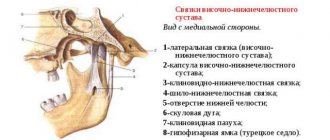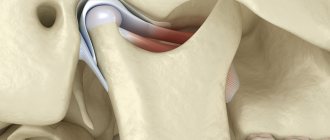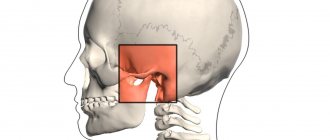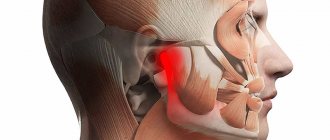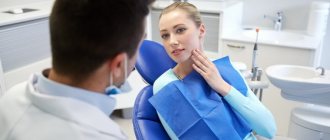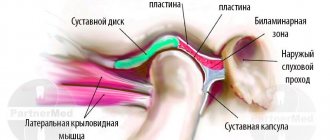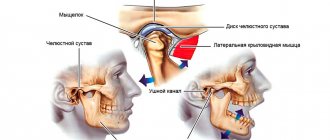Does your jaw click when chewing or when at rest? This is an alarming symptom that indicates certain pathologies of the dental system. It is imperative to consult a dentist, since wasting too much time can lead to inflammation of the joints, loss of teeth and other negative consequences that will have to be treated surgically.
What problems do 70% of dental patients face?
- jaw crunch
- difficulty opening
- pain and discomfort
- clicking sound when chewing
Unfortunately, more and more people are beginning to experience problems with the TMJ (temporomandibular joint) and seek help from a gnathologist. How does the joint work, what problems can arise and what needs to be done in order to protect the health of your teeth and the dental system as a whole.
There are three main problems associated with TMJ:
- Sound or clicking sound in one or both jaw joints
- Significant restriction in opening and closing the jaws
- Pain in the joint and area around it
This triad of symptoms follows each other, occurring one after the other. And in order to understand the essence of solving these problems, it is very important to know the structure of the joint itself.
Preventive measures
The main preventive measure against the development of TMJ diseases is careful attention to the condition of the body as a whole.
Regarding the prevention of clicking in the jaw, experts recommend the following:
- treat dental diseases at the initial stages of their development;
- removed or damaged teeth should be immediately replaced with artificial analogues;
- After receiving an injury, immediately consult a doctor;
- treat ear, nose and throat diseases in a timely manner;
- Do not eat too hard and hard foods.
These simple tips will help you maintain healthy jaw joints for life.
The video provides additional information on the topic of the article.
Structure of the TMJ (temporomandibular joint)
The temporomandibular joint consists of the following elements:
- head of the mandible
- mandibular fossa
- articular tubercle
- articular disc
- capsule and ligaments
The articular head is an ellipsoidal bone formation at the end of the condylar processes of the lower jaw.
An articular disc is a biconcave plate consisting of coarse fibrous connective tissue. It has an oval shape. Located between the articular surfaces, it isolates the articular head from the mandibular fossa, dividing the joint cavity into two floors (upper and lower), the disc is fused at the edges with the joint capsule.
Possible complications
If the jaw joint clicks and there is no other discomfort, then this cannot be ignored by a specialist. The dentist must examine and examine the patient, after which the patient receives instructions on therapy and prevention.
The appearance of a crunch may herald the development of serious inflammatory processes that will affect the ear, trigeminal nerve and other organs.
This threatens:
- joint diseases and dysfunction;
- hearing loss;
- severe neuralgia, in which the pain is so severe that the facial expression of the suffering person is called suicidal;
- spasms of the chewing muscles, which can spread to the neck muscles and even complicate the work of the spine.
You will find more details about the disease and possible complications in the video in this article.
What to do if your jaw starts to crack?
If, when opening the mouth, the patient hears a clicking sound, this means that the articular disc is deformed and displaced from its position to the side. The question is why did the disk "lose" its place and become misaligned? The TMJ has only one support - the bite, the teeth. Correct closure and uniform load on the teeth “save” our joint from the triad of symptoms mentioned above.
The next stage after a crunch or click, patients note difficulties in opening the mouth or problems in closing it.
The reason why such problems arise is due to the fact that the disc is not fixed “in its place”, it either jumps onto the condyle, then slides off it, and then at one point the jaw simply jams. The patient cannot open or close his mouth. At this moment, a protective reflex is triggered, the person begins to panic, the muscles work in an enhanced maximum mode to help the jaw return to its usual initial state, but such an effort, on the contrary, only leads to aggravation of the situation.
And now we are talking about the third stage, when pain is observed in the joint and around it.
The pain occurs as a result of the fact that the articular disc has become deformed and slipped, has ceased to share the space between the skull and the condyle, the bones simply begin to rub against each other, as a result, the head of the TMJ wears off and loses its shape.
Also, one of the causes of pain is that without articular cartilage, the nerves and blood vessels in the joint are compressed, hence the sharp pain that radiates to the head and temporal region, dizziness and nausea appear. The pain begins to cover all surrounding tissues, muscles and teeth. At this stage, patients may complain of hearing loss, tinnitus, and ear congestion.
Why does my jaw click when I open my mouth?
Most often, such clicking is caused by jaw arthritis. This pathology affects the cartilage layer of the joint or meniscus. Accordingly, the meniscus becomes thinner, the fibers become looser, and the cartilage can partially fuse with the articular head. As a rule, the clicks in this case are multiple, resembling a crunch.
The sound is formed as a result of the movement of the articular heads, which overcome the boundary in the form of folds of the cartilage disc. This crunch can be muffled, and therefore only audible to the person himself. Very often the jaw crunches when the mouth is opened sharply, when subluxation of the joint occurs. With some difficulties, but the jaw can be returned to its place. But sometimes this is impossible on your own - the patient is diagnosed with a dislocation, and here the help of a surgeon will be required.
TMJ dysfunction syndrome
This entire triad of symptoms is called “TMD syndrome (temporomandibular joint dysfunction). This syndrome is too difficult to treat; unfortunately, one doctor alone cannot cope with such a situation. A comprehensive treatment is required, in which doctors such as a gnathologist, orthopedist, orthodontist, and sometimes a surgeon will take part. That is why it is very important to consult a doctor with the first signs in order to prevent the disease in time.
How effective is therapeutic exercise?
After eliminating the causes of the disease, the doctor prescribes restorative exercises to the patient, or rather a set of exercises that will help improve the functionality of the masticatory muscles.
Joint exercises are performed after thermal preparation of muscle structures with a warm compress. The duration of the manipulation is no more than 10 minutes.
Good results can be achieved with the following exercises:
- Move your movable jaw forward and backward 10 times in each direction.
- Move your jaw first to the right and then to the left with your lips parted. Repeat at least 10 times.
- Press the chin area with your hand and try to forcefully lift your jaw up. The duration of the movement is at least 1 minute.
- Try pushing your jaw forward for 1 minute, pressing with your fingers on both sides of the chin.
Crunching jaw: how to treat and which doctor to contact
The first question that arises for people who are faced with crunching and discomfort in the jaw is what should be done, which doctor should they contact, should they do anything at all? It all depends on how long ago the jaw began to crunch, what caused this unpleasant phenomenon, whether the crunch is accompanied by other symptoms, and whether it limits the movement of the jaw. It is important that in no case should you self-medicate, which can aggravate the situation, and postpone a visit to the doctor.
Treatment of TMJ by our experienced gnathologists who:
- are able to carry out accurate diagnostics and apply their results in practice
- high-quality diagnostics using more than 50 parameters
- know how to treat so that the first result is noticeable within 7 days
- can prove their experience with successful results of more than 524 satisfied patients with TMJ problems
- quality treatment at prices in the residential area of Yasenevo
Diagnostic measures
The doctor begins the search for the causes of crunching and clicking in the jaw by interviewing the patient and visual examination. The orthodontist palpates the lower jaw and mandibular joint and determines the type of bite.
In some cases, a consultation with a neurologist and a study of the motor and sensory functions of the trigeminal nerve system are prescribed.
For accurate diagnosis, a number of research activities are used:
- biochemical blood and urine tests to determine the presence of inflammatory processes;
- ultrasonography;
- radiography;
- EMG – functional diagnostics of the state of muscle and nervous tissue, as well as neuromuscular transmission;
- arthroscopic surgical procedure (minimally invasive intervention to study various joint pathologies and diseases);
- CT scan;
- Magnetic resonance imaging.
Classification of pathology depending on its manifestations:
- The clicking sound occurs on one side of the jaw . The clinical picture indicates dysfunction of the lower jaw. In medical practice, a unilateral defect is more common.
- The lower jaw clicks on the right. The symptom indicates a malfunction of the TMJ in the area of the right chewing molars.
- The sound occurs near the left ear . Symptoms indicate joint dislocation or arthrosis. In advanced cases, partial hearing loss is possible.
If the sound occurs rarely and is not accompanied by discomfort, this phenomenon may be natural and physiological in nature. You should be concerned if the uncharacteristic sound is repeated frequently and is accompanied by inflammation or pain.
Why is a displacement of the midline of teeth dangerous and how to correct the defect.
Come here to find out how to correct a crooked jaw.
At this address https://orto-info.ru/zubocheliustnye-anomalii/chelyustey/sovremennyie-metodyi-ispravleniya-malenkoy-nizhney.html read what to do if a child is diagnosed with a small lower jaw.
Sinusitis, maxillary sinus cyst, loss of sense of smell after visiting the dentist
The roots of the teeth of the upper jaw can normally be adjacent to the maxillary (maxillary) sinuses of the nose and even survive in them . Sinusitis, maxillary sinus cyst and loss of smell are possible when infection or filling material penetrates from the teeth into the paranasal sinuses. Unfortunately, this is not uncommon. Moreover, some cases of persistently recurrent sinusitis are associated with infection penetrating from the roots of the teeth . In this case, a possible symptom is a strong unpleasant odor from the nose and mouth.
Odontogenic sinusitis after treatment by a dentist
Odontogenic sinusitis (scheme). Teeth and maxillary sinus. On the left is the norm. On the right – the root of the “seven” (tooth 2_7) is destroyed, inflammation around the destroyed root, pus in the maxillary sinus.
Filling material in the maxillary sinus and sinusitis after filling the “six” canals (tooth 2_6). Pain in the left side of the face after visiting the dentist.
1 – roots of teeth, 2 – normal, air in the right maxillary sinus (front view, the air looks black in the picture), 3 – in the left maxillary sinus there is a fragment of filling material surrounded by an inflammatory shaft. The patient had been mistakenly receiving treatment for trigeminal neuralgia for a long time.
Cysts of the maxillary (maxillary) sinuses in diseases of the roots of the teeth.
1 – roots of the teeth, 2 – cysts of the maxillary sinuses, growing from the roots of the teeth (cysts are round “bubbles”, they look gray in the picture).
How can we help you:
- Let's find the source of pain after dental treatment;
- We will treat inflammatory processes, sinusitis, sinusitis and neurological complications; if necessary, your health will be taken care of jointly by a neurologist and an ENT doctor. Treatment of sinusitis without puncture
